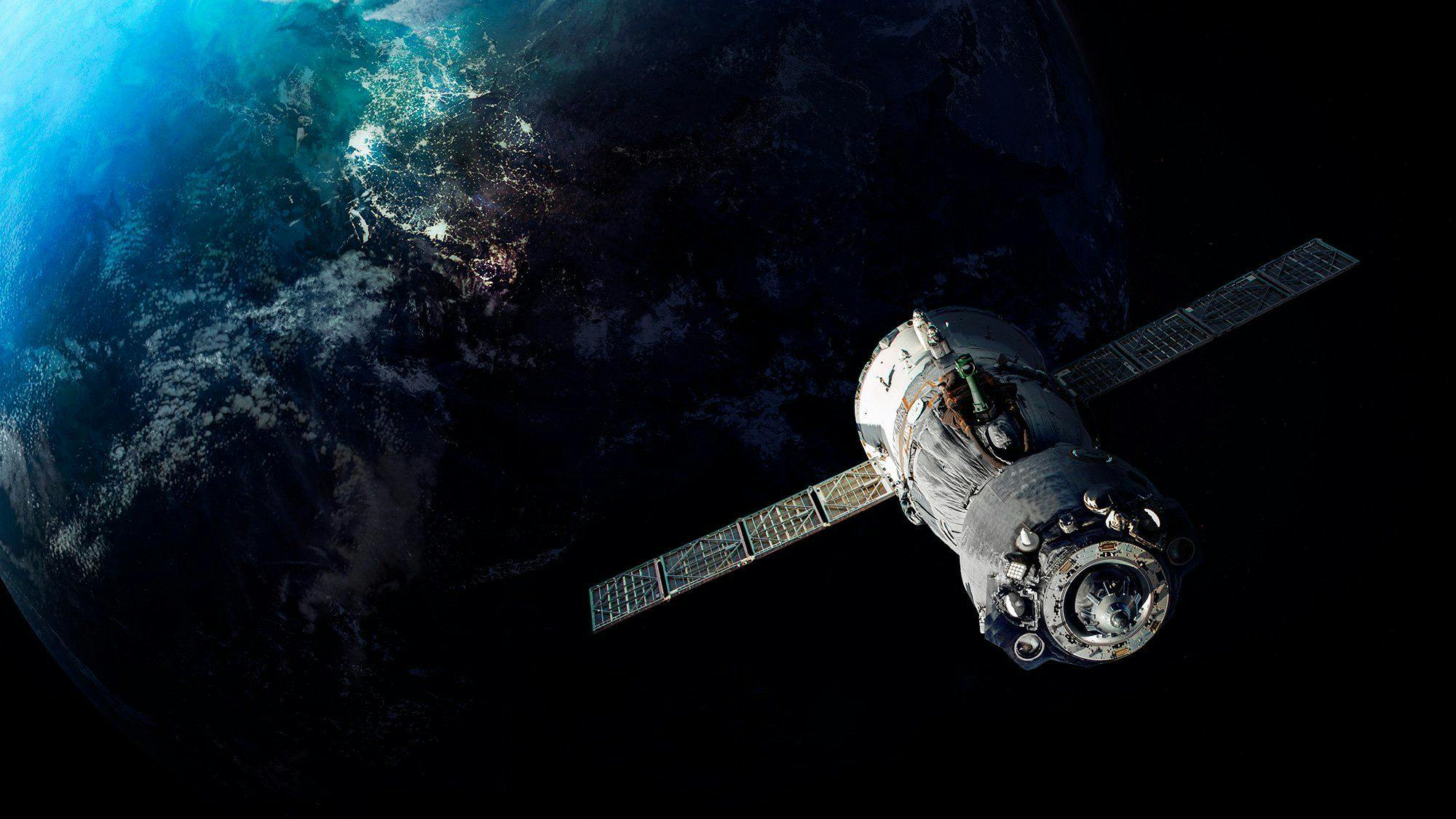In the history of cinema and cosmonautics, there are films shot in space, films shot by cosmonauts, films featuring cosmonauts, films shot by automatic spacecraft, films with real weightlessness but shot within the Earth’s atmosphere, and many other variations. Today we are talking about cinema in space and space in cinema.
The first film about space
The first public, and then commercial, film screenings began in 1895. And just seven years later, in 1902, the first known (and most likely the first ever) film about space and cosmonautics was released – “A Trip to the Moon” by French director Georges Méliès. Short by today’s standards, at the time it was a full-fledged science fiction blockbuster lasting a full 15 minutes. The plot parodied Jules Verne’s “From the Earth to the Moon” and H. G. Wells’ “The War of the Worlds”. The film was initially shown to great success in cinemas on both sides of the Atlantic, then forgotten, rediscovered in the 1930s, and now rightfully occupies a place of honor in the pantheon of world cinema. The shot of the “face” of the moon, which was hit by a shell, has become one of the most famous and frequently cited in the entire history of cinema.
Nowadays, it is necessary to explain that the projectile is loaded into the cannon by girls not just in strange clothes, but in swimsuits. But this prediction has not yet come true, and models in bikinis do not see off cosmonauts and astronauts on their flights. Take fifteen minutes and watch the film, it’s worth it.
The first serious film about space
A quarter of a century later, the first film realistically depicting the launch of a lunar rocket was made in Germany. “Woman in the Moon” was directed by Fritz Lang and released in 1929. According to some critics, the realistic depiction of a rocket launch was the director’s main idea. Whether this is true or not, the famous rocket and space enthusiast Hermann Obert was brought in as a consultant, who was also supposed to demonstrate the launch of a model rocket as part of an advertising campaign, for which he received significant funding from the film studio. Obert did not make it in time for the film and launched Europe’s first liquid-fuel rocket in 1931.
When real space flights began, it turned out that “Woman in the Moon” had predicted: vertical transport of the rocket to the launch site (one of the transport options), the countdown, the use of water at the launch complex (though not as in the film), anti-g seats (in reality, chairs), the spectacle of the first stage separation, and much more. Seventeen-year-old Wernher von Braun also worked as an assistant on the film set.
The first serious Soviet film about space
Soviet filmmakers were no strangers to science fiction—Protazanov’s “Aelita”, based on the novel by Alexei Tolstoy, was filmed back in 1924, but it only briefly shows the launch of a spaceship from a roofless house on the “remote outskirts of Moscow.” But the film “Cosmic Voyage” had none other than Tsiolkovsky himself as a consultant. Released in 1936, the film has some similarities with “Woman in the Moon”: in both films, the characters fly to the moon, the expedition is led by a prominent scientist, there is a woman in the crew, and a teenager sneaks on board. But “Cosmic Voyage” shows Tsiolkovsky’s vision: the rocket takes off from a launch pad (a relatively rare option today), and baths, or more precisely, containers with liquid, are used to protect against overload (a solution used only in unmanned spaceflight).
There are characteristic misconceptions, such as the impossibility of radio communication with Earth and the need to signal with pyrotechnic rockets because of this. But unlike in “Woman in the Moon”, weightlessness is shown correctly—it occurs immediately after the engine is turned off. The film is also interesting for its use of the word “astronaut,” as “cosmonaut” appeared much later.
It is worth noting the special effects, which look surprisingly good for a film that is almost a century old and have become, in a sense, the standard. Weightlessness was shown by suspending the actors on cables, and the scenes in the rocket hangar and jumping on the moon were filmed on miniature models and using puppet animation.
First images from space
The first photo and video in space were taken on October 24, 1946, by an automatic camera mounted on a modified V-2 rocket, originally a combat rocket, launched from the US White Sands test site. The rocket rose to an altitude of 104.6 km, and the camera installed on it took one frame every 1.5 seconds. A few minutes later, the rocket and the camera fell back to earth and crashed, but the film in a special capsule was safely retrieved and developed. The camera was developed by Clyde Holliday, who worked at Johns Hopkins University.
Since then, cameras have become a permanent part of space cargo — they are placed on rockets and interplanetary stations and sent along with astronauts.
The first photos of the entire Earth from space
The first photo of the entire Earth was taken on May 30, 1966, by a camera installed as a piggyback payload on a Soviet Molniya-1 communications satellite (most likely No. 6, launched in April), flying in a highly elliptical orbit with a large inclination. It is difficult to make out anything in the photo, but from the orbit parameters it is clear that this must be the northern hemisphere.
The first color photo was taken by the American experimental satellite DODGE. The main task of the device was to test the gravitational stabilization system, and the camera was also carried as a piggyback payload. The black-and-white camera took three pictures through color filters, and the image was assembled on Earth. Incidentally, Clyde Holliday, whom you already know, participated in its processing.
The first photographer and videographer in space
The first person to take photos and videos in space was German Titov on August 6, 1961. Yuri Gagarin had a fixed television camera in his spacecraft that filmed the cosmonaut’s face, but not what was happening outside, and he was not given a camera due to the relatively short flight. The American astronauts who made two suborbital flights after Gagarin had three cameras in their spacecraft: one filmed the astronaut, the second filmed the instrument panel, and the third looked out the porthole, but all of them were automatic. However, German Titov flew in orbit for a whole day, so he had time to operate the camera and video camera himself.
Since then, cosmonauts have taken photography courses as part of their space training, taken a lot of pictures in orbit, published them and collected thousands of likes on Instagram. After returning, they have organized exhibitions that have attracted a lot of interest and published albums.
Everything grows and develops
It is thanks to automatic cameras that we have images that have become archetypal. American Gemini spacecraft were equipped with cameras looking out of a porthole, which was also conveniently located. As a result, we have images of deceleration in the dense layers of the atmosphere, when the plasma enveloping the spacecraft is clearly visible in the porthole.
Many cameras were used in the Apollo program. They were located at various points on the launch pad and on the rocket itself. The cameras on the rocket were housed in containers, turned on automatically, then ejected and descended into the ocean on parachutes equipped with radio beacons. As a result, humanity has some truly spectacular footage of the separation of the stages.
Science fiction
In the 1960s, two science fiction universes were born that are still alive today and have huge fan communities. In 1963, the British series “Doctor Who” appeared, about an eccentric alien who travels through time and space, and in 1966, the American series Star Trek appeared, about the adventures of the crew of the starship Enterprise. The series were broadcast on TV, so they couldn’t boast a large budget. As a result, it was space fiction in which space was hardly shown at all. The landscapes of other planets were filmed in studios or in some sandy quarry (a cliché particularly characteristic of “Doctor Who”). Aliens were portrayed by people equipped with the necessary amount of vinyl, plastic, pine cones, acorns, and similar materials.
The “Doctor Who” spaceship and time machine TARDIS simply materialized at the desired point, while “Star Trek” showed a large-scale model of the ship against the backdrop of, for example, a painted planet. Already in the 21st century, a remaster was made with simple but attractive computer special effects.
Serious special effects with a large budget could be found in feature films, the archetypal example of which was Stanley Kubrick’s “2001: A Space Odyssey”, released in 1968. Filmed in the canons of hard science fiction, the film honestly tried to show space using available technology. The actors, as in “Cosmic Voyage”, hung on cables, except that they tried to hide them better, without revealing the actor’s movement along the pendulum trajectory.
The force of gravity directed from the axis to the periphery on the orbital station was demonstrated by constructing a large set, inside which an actor ran like a squirrel in a wheel.
The models of the technology were combined with the background using various animation and combined shooting techniques, creating a sense of scale with slow-motion shots when necessary. At the time of release, the result was impressive.
One striking prediction in “2001: A Space Odyssey” was that the shots of running around the station were later filmed in real space—on the large Skylab station, real astronauts ran in much the same way. However, in real weightlessness, they had more freedom, and it would have been much more difficult to film the astronauts’ somersaults in “2001: A Space Odyssey.”
Documentary films
The development of photo and movie cameras did not bypass space. When IMAX technology appeared in the 1970s, astronauts began to use it to film. In 2002, the first 3D film, Space Station 3D, was released. As a result, humanity has a huge number of documentary films about space. Among those made in Russia, it is worth watching the series Space Odyssey, 21st Century and A Year in Orbit.
The first feature film in space
The first film to use footage shot specifically in space was the Soviet film “Return from Orbit” (1984). Cosmonauts filmed on the Salyut 7 space station and in the Soyuz T-9 spacecraft. Considering that the actors remained on Earth, it is likely that these shots of a stopwatch rotating in zero gravity were filmed.
Real weightlessness
Most likely, the only film that features footage of real weightlessness not shot in space is Apollo 13. The film crew, actors, and set were placed in a flying laboratory aircraft used in cosmonaut training. The plane gains altitude and begins to describe parabolas, creating weightlessness for short periods of up to 30 seconds. And here’s the backstage.
In the 21st century, the need for such tricks has largely disappeared — you can film actors against a green screen and then add whatever you want on the computer. The most striking example of this approach is Alfonso Cuarón’s “Gravity.”
Nowadays, the realism of films depends mainly on the screenwriters, the violations of the laws of nature they are willing to commit in order to portray the desired drama.
Filmed by astronauts
There are feature films shot by astronauts. Space tourist Richard Garriott, who traveled to the ISS in 2008, brought a science fiction film script to the station, which was shot during the crew’s free time. “Apogee of Fear!” was released in 2012 and can be viewed on YouTube.






























